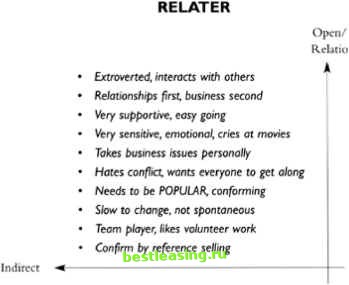

 |
 |

|
Промышленный лизинг
Методички
  previous I next ЦШ И1:11 How Will I Know When I See One? There are two primary indicators of ones style, verbal and visual. As Tony Alessandra suggests, there are observable characteristics for each style-visual indicators such as environment, dress, vehicle, office, and how each verbalizes thoughts and ideas. As well, be cognizant of nonverbal gestures. By observing how customers dress and express themselves, and by listening to how and what they say, you will quickly begin to identify their styles. I suggest you begin by asking yourself, Is he or she an introvert or an extrovert? These traits can be rather obvious in their approach, dress, and work environment. Look around their corporate livingroom (office) and observe what is and isnt there, including pictures, awards, certificates, type of furniture, toys, bric-a-brac, and so on. Then narrow it down to a particular quadrant, keeping in mind that each individual exhibits characteristics and behaviors from each quadrant. People are not restricted to the conduct associated with just one style.  Different Versus Difficult Know the difference between different and difficult. Unfortunately, it seems that few people do. We are often too quick to label someone as difficult when they act or behave in a manner contrary to our behavior. You see, people are not difficult, they are just different. Its far too easy to label them as difficult, rather than make the effort to understand them and appreciate their differences. Thats what makes this tool such an asset to your professional equity. Understand that people-your customers- are different. The key to a lasting, trusting relationship is an adaptation to their style. Abraham Lincoln once said, I dont like that man very much; I need to get to know him better. What a great concept, one from which we could all benefit. As a new salesperson with a company, you may have heard (or even said) this: Dont bother going to see Hank at XYZ Company. He is such a jerk and a real tough guy to get along with. Plus, he never buys anything-hes always just looking. Hank may very well be a jerk (they do exist) but chances are that Hank is simply a different style type. Hank is probably a neat guy once you get to know him. A case in point: I recently received a call from an excited graduate of my sales program. She was ecstatic because she had just confirmed business with an account that had been labelled indifferent and not likely to buy from her. She persevered, and with the help of behavioral flexibility she secured a $100,000 account. Not a bad return on her training investment. Another important aspect of successful adaptation is your willingness and confidence to stretch your comfort zone. As discussed in Chapter 2, stretching your comfort zone is one of the pillars of success, and is certainly a necessary attitude for successful implementation of behavioral flexibility. We must be willing and able to stretch our range to accommodate other peoples styles. So who makes the best salesperson? Before I answer this common question, put the book down and give it some thought. Ill wait. The answer is ... the chameleon-the salesperson who can readily adapt to the style of each customer. It doesnt matter which style you are. What matters is how quickly and comfortably you can adapt to the style of the person you are interacting with, at home or at work. 
1 2 3 4 5 6 7 8 9 10 11 12 13 14 15 16 17 18 19 20 21 22 23 24 25 26 27 28 29 30 31 [ 32 ] 33 34 35 36 37 38 39 40 41 42 43 44 45 46 47 48 49 50 51 52 53 54 55 56 57 58 59 60 61 62 63 64 65 66 67 68 69 70 71 |